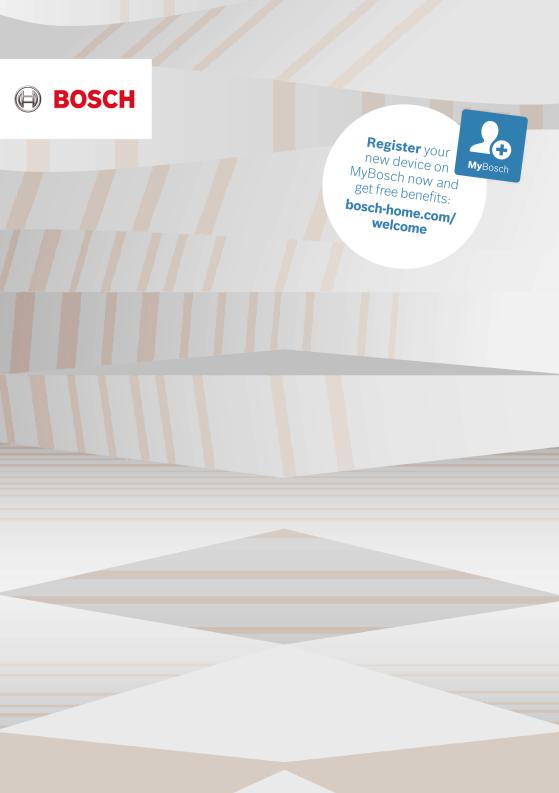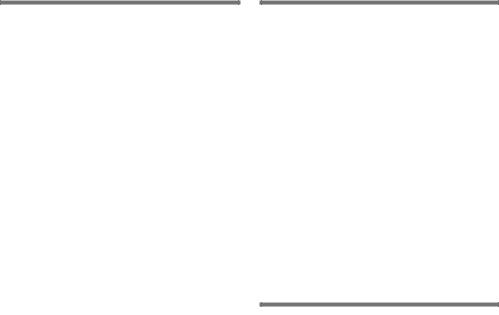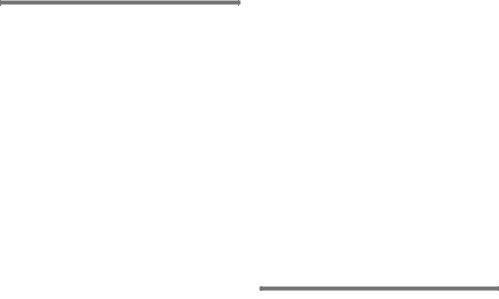Bosch KDN43N120M, KDN43NL2E8, KDN43N1208, KDN26N12E8, KDN30N12E8 Instructions for Use
...
Fridge-freezer
KDN..
en |
Instructions for use |
Fridge-freezer |
4 |
fr |
Notice d’utilisation |
Combiné réfrigérateur-congélateur |
22 |
pt |
Instruções de serviço |
Combinação de frigorífico e congelador |
44 |

en Table of contents |
|
Safety and warning information ........... |
4 |
Information concerning disposal ......... |
7 |
Scope of delivery ................................... |
7 |
Installation location ................................ |
8 |
Fitting the wall spacer ........................... |
8 |
Aligning the appliance .......................... |
8 |
Observe ambient temperature |
|
and ventilation ........................................ |
8 |
Connecting the appliance .................... |
9 |
Getting to know your appliance ........ |
10 |
Switching on the appliance ................ |
10 |
Setting the temperature ...................... |
11 |
eco .......................................................... |
11 |
Alarm functions .................................... |
11 |
Usable capacity .................................... |
12 |
Refrigerator compartment .................. |
12 |
Freezer compartment .......................... |
13 |
Freezing capacity ................................. |
13 |
Freezing and storing food .................. |
13 |
Freezing fresh food ............................. |
14 |
Super freezing ...................................... |
15 |
Thawing frozen food ............................ |
15 |
Interior fittings ....................................... |
15 |
Switching off and disconnecting |
|
the appliance ........................................ |
16 |
Cleaning the appliance ....................... |
17 |
Light (LED) ............................................ |
17 |
Tips for saving energy ........................ |
18 |
Operating noises ................................. |
18 |
Eliminating minor faults yourself ....... |
19 |
Customer service ................................. |
21 |
fr Table des matières |
|
Prescriptions-d’hygiène-alimentaire .. 22 |
|
Consignes de sécurité |
|
et avertissements ................................. |
22 |
Conseil pour la mise au rebut ........... |
26 |
Étendue des fournitures ..................... |
27 |
Lieu d’installation ................................. |
27 |
Monter les écarteurs muraux ............. |
28 |
Ajuster l’appareil .................................. |
28 |
Contrôler la température ambiante |
|
et l’aération ............................................ |
28 |
Branchement de l’appareil ................. |
29 |
Présentation de l’appareil ................... |
30 |
Mise en service de l'appareil ............. |
31 |
Réglage de la température ................ |
31 |
« eco » ................................................... |
32 |
Fonctions d'alarme .............................. |
32 |
Contenance utile .................................. |
33 |
Le compartiment réfrigérateur ........... |
33 |
Compartiment congélateur ................ |
34 |
Capacité de congélation .................... |
34 |
Congélation et rangement ................. |
34 |
Congélation de produits frais ............ |
35 |
Supercongélation ................................. |
36 |
Décongélation des produits .............. |
36 |
Equipement ........................................... |
36 |
Arrêt et remisage de l'appareil .......... |
37 |
Nettoyer l’appareil ................................ |
38 |
Éclairage (LED) .................................... |
38 |
Economies d’énergie .......................... |
39 |
Bruits de fonctionnement ................... |
39 |
Remédier soi même aux petites |
|
pannes ................................................... |
40 |
Service après-vente ............................. |
43 |

pt Índice |
|
Instruções de segurança e de |
|
aviso ....................................................... |
44 |
Instruções sobre reciclagem ............. |
47 |
O fornecimento inclui .......................... |
48 |
Local da instalação ............................. |
49 |
Montar o distanciador da parede ..... |
49 |
Alinhar o aparelho ............................... |
49 |
Ter em atenção a temperatura |
|
ambiente e a ventilação ..................... |
50 |
Ligar o aparelho ................................... |
50 |
Familiarização com o aparelho ......... |
51 |
Ligar o aparelho ................................... |
52 |
Regular a temperatura ........................ |
52 |
«eco» ...................................................... |
53 |
Funções de alarme .............................. |
53 |
Capacidade útil .................................... |
54 |
Zona de refrigeração .......................... |
54 |
Zona de congelação ........................... |
55 |
Capacidade de congelação .............. |
55 |
Congelação e conservação ............... |
55 |
Congelação de alimentos frescos |
.... 56 |
Supercongelação ................................. |
57 |
Descongelação dos alimentos ......... |
57 |
Equipamento ......................................... |
58 |
Desligar e desactivar o aparelho |
..... 59 |
Limpeza do aparelho .......................... |
59 |
Iluminação (LED) ................................. |
60 |
Como poupar energia ........................ |
60 |
Ruídos de funcionamento .................. |
60 |
Eliminação de pequenas |
|
anomalias .............................................. |
61 |
Serviço de Assistência Técnica ........ |
64 |

en
Safety and warning information
Before you switch ON the appliance
Please read the operating and installation instructions carefully! They contain important information on how to install, use and maintain the appliance.
The manufacturer is not liable if you fail to comply with the instructions and warnings. Retain all documents for subsequent use or for the next owner.
Technical safety
Fire hazard
The tubes of the refrigeration circuit convey a small quantity of an environmentally friendly but flammable refrigerant (R600a). It does not damage the ozone layer and does not increase the greenhouse effect. If refrigerant escapes, it may injure your eyes or ignite.
If damage has occurred
■Keep naked flames and/or ignition sources away from the appliance,
■thoroughly ventilate the room for several minutes,
■switch off the appliance and pull out the mains plug,
■inform customer service.
The more refrigerant an appliance contains, the larger the room must be in which the appliance is situated. Leaking refrigerant can form a flammable gas-air mixture in rooms which are too small. The room must be at least 1 m³ per 8 g of refrigerant. The amount of refrigerant in your appliance is indicated on the
rating plate inside the appliance.
When installing the appliance, ensure that the mains cable is not trapped or damaged.
If the power cord of this appliance is damaged, it must be replaced by the manufacturer, Customer Service or a similarly qualified person. Improper installations and repairs may put the user at considerable risk.
Repairs may be performed by the manufacturer, customer service or a similarly qualified person only.
4

Only original parts supplied by the manufacturer may be used. The manufacturer guarantees that only these parts satisfy the safety requirements.
Do not use multiple sockets, extension leads or adapters.
Fire hazard
Portable multiple outlets or power supplies may overheat, causing a fire.
Never leave portable multiple outlets or portable power supplies behind the appliance.
Important information when using the appliance
■Never use electrical appliances inside the appliance (e.g. heaters, electric ice makers, etc.). Risk of explosion!
■Never defrost or clean the appliance with a steam cleaner! The steam may penetrate electrical parts and cause a short-circuit. Risk of electric shock!
■Do not use additional means to accelerate the defrosting process other than those recommended by the manufacturer. Risk of explosion!
en
■Do not use pointed or sharpedged implements to remove frost or layers of ice. You might damage the refrigerant tubes.Leaking refrigerant may cause eye injuries or ignite.
■Do not store products which contain flammable propellant (e.g. spray cans) or explosive substances in the appliance. Risk of explosion!
■Do not stand on or lean heavily against the base of the appliance, drawers, doors, etc.
■For defrosting and cleaning, pull out the mains plug or switch off the fuse. Do not pull out the mains plug by tugging on the power cord.
■Store high-percentage alcohol tightly sealed and in an upright position.
■Keep plastic parts and the door seal free of oil and grease. Otherwise, plastic parts and the door seal will become porous.
■Never cover or block the ventilation openings of the appliance.
■Do not store bottled or canned liquids (especially carbonated drinks) in the freezer compartment.Bottles and cans may burst!
5
en
■Never put frozen food straight from the freezer compartment in your mouth.
Risk of low-temperature burns!
■Avoiding placing children and vulnerable people at risk:
At risk here are children, people who have limited physical, mental or sensory abilities, as well as people who have inadequate knowledge concerning safe operation of the appliance.
Check that children and vulnerable people have understood the hazards.
A person responsible for safety must supervise or instruct children and vulnerable people who are using the appliance.
Only children aged 8 years and above may use the appliance.
Supervise children while the appliance is being cleaned or maintained.
Never allow children to play with the appliance.
■Avoid prolonged touching of frozen food, ice or the evaporator pipes, etc.
Risk of low-temperature burns!
Children in the household
■Keep children away from packaging and its parts. Danger of suffocation from folding cartons and plastic film!
■Do not allow children to play with the appliance!
■If the appliance features a lock:
keep the key out of the reach of children!
General regulations
The appliance is suitable
■for refrigerating and freezing food,
■for making ice.
This appliance is intended for use in the home and the home environment.
The refrigeration circuit has been checked for leaks.
This appliance complies with the relevant safety regulations for electrical appliances and is fitted with noise suppression.
This appliance is intended for use up to a maximum height of 2000 metres above sea level.
6

Information concerning disposal
* Disposal of packaging
The packaging protects your appliance from damage during transit. All utilised materials are environmentally safe and recyclable. Please help us by disposing of the packaging in an environmentally friendly manner.
Please ask your dealer or inquire at your local authority about current means of disposal.
* Disposal of your old appliance
Old appliances are not worthless rubbish! Valuable raw materials can be reclaimed by recycling old appliances.
This appliance is labelled in
accordance with European Directive 2012/19/EU concerning used electrical and electronic appliances (waste electrical and electronic equipment - WEEE). The guideline determines the framework for the return and recycling of used appliances as applicable throughout the EU.
en
m Warning
Redundant appliances
1.Pull out the mains plug.
2.Cut off the power cord and discard with the mains plug.
3.Do not take out the trays and receptacles: children are
therefore prevented from climbing in!
4.Do not allow children to play with the appliance once it has spent its useful life. Danger of suffocation!
Refrigerators contain refrigerant and gases in the insulation. Refrigerant and gases must be disposed of professionally. Ensure that tubing of the refrigerant circuit is not damaged prior to proper disposal.
Scope of delivery
After unpacking all parts, check for any damage in transit.
If you have any complaints, please contact the dealer from whom you purchased the appliance or our customer service.
The delivery consists of the following parts:
■Free-standing appliance
■Interior fittings (depending on model)
■Bag containing installation materials
■Operating instructions
■Installation manual
■Customer service booklet
■Warranty enclosure
■Information on the energy consumption and noises
7

en
Installation location
A dry, well ventilated room is suitable as an installation location. The installation location should not be exposed to direct sunlight and not placed near a heat source, e.g. a cooker, radiator, etc. If installation next to a heat source is unavoidable, use a suitable insulating plate or observe the following minimum distances from the heat source:
■3 cm to electric or gas cookers.
■30 cm to an oil or coal-fired cooker.
The floor of the installation location must not give way; if required, reinforce floor. If the floor is uneven, compensate with supports.
Distance from wall
When installing the appliance, ensure that the door can be opened by 90°.
Fitting the wall spacer
Fit wall spacers to obtain the indicated energy rating of the appliance.
A reduced wall gap will not restrict
the function of the appliance. The energy rating may then increase slightly.
Distance to the back wall
The distance of 75 mm must not be exceeded.
Aligning the appliance
Place the appliance in the designated location and align.The appliance must be level and stand securely on the floor. If the floor is uneven, use the front heightadjustable feet. Adjust the heightadjustable feet with a spanner.
Note
The appliance must be vertical. Please align it with a spirit level.
Observe ambient temperature
and ventilation
Ambient temperature
The appliance is designed for a specific climate class. Depending on the climate class, the appliance can be operated at the following temperatures.
The climate class can be found on the rating plate. Fig. )
Climate class |
Permitted ambient |
|
temperature |
SN |
+10 °C to 32 °C |
N |
+16 °C to 32 °C |
ST |
+16 °C to 38 °C |
T |
+16 °C to 43 °C |
Note
The appliance is fully functional within the room temperature limits of the indicated climatic class. If an appliance of climatic class SN is operated at colder room temperatures, the appliance
will not be damaged up to a temperature of +5 °C.
8

Ventilation
Fig. $
The air on the rear panel and on the side panels of the appliance heats up. Conduction of the heated air must not be obstructed. Otherwise, the refrigerating unit must work harder. This increases power consumption. Therefore: Never cover or block the ventilation openings!
Connecting the appliance
After installing the appliance, wait at least 1 hour until the appliance is switched on. During transportation the oil in the compressor may have flowed into
the refrigeration system.
Before switching on the appliance for the first time, clean the interior of the appliance (see chapter “Cleaning the appliance”).
Electrical connection
The socket must be near the appliance and also freely accessible following installation of the appliance.
en
m Warning
Risk of electric shock!
If the length of the mains cable is inadequate, never use multiple sockets or extension leads. Instead, please contact Customer Service for alternatives.
The appliance complies with protection class I. Connect the appliance to 220– 240 V/50 Hz alternating current via a correctly installed socket with protective conductor. The socket must be protected by a 10 A to 16 A fuse.
For appliances operated in nonEuropean countries, check whether the indicated voltage and current type match the values of your electricity supply. This information can be found on the rating plate, Fig. ).
m Warning
Never connect the appliance
to electronic energy saver plugs.
Our appliances can be used with mains and sine-controlled inverters. Mainscontrolled inverters are used
for photovoltaic systems which
are connected directly to the national grid. Sine-controlled inverters must be used for isolated applications (e.g. on ships or in mountain lodges) which are not connected directly to the national grid.
9

en
Getting to know your appliance
Please fold out the illustrated last page. These operating instructions refer
to several models.
The features of the models may vary. The diagrams may differ.
Fig. !
* Not all models.
AFreezer compartment
BRefrigerator compartment
1–4 Controls
5Light (LED)
6Fast freezer compartment 7* Ice pack
8Condensation channel 9* Door shelf
10Temperature controller 11* Bottle shelf
12Shelf in the refrigerator compartment
13Vegetable container
14Height-adjustable feet
15Shelf for small bottles
16Shelf for large bottles
Controls
Fig. "
1Temperature selection button
The required temperature is set with this button.
2“super” display (freezer
compartment)
Illuminates when super freezing is on.
3Temperature display freezer
compartment
The numbers correspond
to the set freezer compartment temperatures in °C.
4Eco mode indicator
This lights up when the eco mode is switched on.
Switching on the appliance
Fig. "
1.Insert the plug in the socket.
2.A warning signal sounds. The temperature display 3 flashes.
3.Press the temperature setting button 1. The warning signal switches off.
When the freezer compartment has reached the set temperature, the temperature display 3 is lit.
The factory recommends the following settings:
■Refrigerator compartment: medium setting
■Freezer compartment: -18°C
Store delicate foods in the refrigerator compartment.
10

Operating tips
■When the appliance has been switched on, it may take several hours until the set temperatures have been reached.
■The fully automatic NoFrost system ensures that the freezer compartment remains free of ice. Defrosting is no longer required.
■The sides of the housing are sometimes heated slightly. This prevents condensation in the area of the door seal.
■If the freezer compartment door cannot be immediately re-opened after it has been closed, wait until the resulting low pressure has equalised.
Setting
the temperature
Refrigerator compartment
Turn temperature controller, Fig. !/10, to the required setting.
We recommend the setting in line with the marking.
Changing the setting clockwise will lower temperatures in the refrigerator compartment.
At a room temperature below 16°C, slightly increase the temperature setting in the appliance. At a room temperature above 32°C, slightly reduce the temperature setting in the appliance.
Select a very cold setting only temporarily if:
■door is opened frequently,
■large quantities of food are placed in the refrigerator compartment.
en
Freezer compartment
The temperature can be set from -18°C to -24°C.
Keep pressing temperature setting button 1 until the required freezer compartment temperature is set.
The last set value is saved. The set temperature is indicated on temperature display 3.
eco
The “eco” function switches the appliance to energy-saving mode.
The appliance automatically sets the following temperatures:
■ Freezer compartment: -16°C
Switching on eco
Keep pressing the temperature setting button 1 until the eco indicator is highlighted.
Alarm functions
Fig. "
Door alarm
The door alarm (continuous sound) switches on if the appliance door is open for longer than one minute. Close
the door to switch off the warning signal.
11

en
Temperature alarm
The temperature alarm switches on if the freezer compartment is too warm and the frozen food is at risk of thawing.
Temperature display, Fig. "/3, is flashing.
The alarm may switch on without any risk to the frozen food:
■when the appliance is switched on,
■when large quantities of fresh food are placed in the appliance,
■if the freezer compartment door is open too long.
Note
Do not refreeze thawing or thawed food. Only ready meals (boiled or fried) may be refrozen.
No longer store the frozen produce for the max. storage period.
Switching off the alarm
Fig. "
Press the temperature setting button 1 to switch off the warning signal.
Usable capacity
Information on the usable capacity can be found inside your appliance on
the rating plate. Fig. )
Refrigerator compartment
The refrigerator compartment is the ideal storage location for meat, sausage, fish, dairy products, eggs, ready meals
and pastries.
Note when storing food
Note
Optimum cooling capacity is attained when the upper glass shelf remains in position.
■Store fresh, unspoilt food. This will then preserve quality and freshness for longer.
■With ready-made products and bottled goods, observe the best-before or use-by date specified by the manufacturer.
■To preserve aroma, colour and freshness, pack or cover food well before placing in the appliance. This will prevent the transfer of flavours and the discolouration of plastic parts in the refrigerator section.
■Allow hot food and drinks to cool down first before placing in the appliance.
Note
Do not block air outlet openings with food, otherwise the air circulation will be impaired. Food which is stored directly in front of the air outlet openings may be frozen by the cold air flowing out.
Note
Avoid contact between food and rear panel. Otherwise the air circulation will be impaired.
Food or packaging could freeze to the rear panel.
12

Note the chill zones in the refrigerator section
The air circulation in the refrigerator section creates different chill zones:
■The coldest zone is between the vegetable container and the glass shelf situated above and in front of the air outlet openings.
Note
Store perishable food (e.g. fish, sausage, meat) in the coldest zone.
■The warmest zone is at the very top of the door.
Note
Store e.g. hard cheese and butter in the warmest zone. The aroma of hard cheese can then continue to develop and butter remains spreadable.
Vegetable container
Fig. !/13
A high air humidity keeps leafy vegetables fresh for longer. Vegetables and fruit should be stored at a slightly lower air humidity.
The air humidity in the vegetable drawer depends on the amount of stored food.
Note
If the air humidity is too high, drips may form and cause decay.
en
Freezer compartment
Use the freezer compartment
■To store deep-frozen food.
■To make ice cubes.
■To freeze food.
Note
Ensure that the freezer compartment door has been closed properly. If the door is open, the frozen food will thaw. The freezer compartment will
become covered in thick ice. Also: waste of energy due to high power consumption!
Freezing capacity
Information on the freezing capacity can be found on the rating plate. Fig. )
Freezing and storing food
Purchasing frozen food
■Packaging must not be damaged.
■Use by the “use by” date.
■Temperature in the supermarket freezer must be -18 °C or lower.
■If possible, transport deep-frozen food in an insulated bag and place quickly in the freezer compartment.
13

en
Note when loading products
Freeze large quantities of food in the fast freezer compartment where food freezes particularly quickly and therefore also gently.
Food which is already frozen must not come into contact with the food which is to be frozen.
Freezing fresh food
Freeze fresh and undamaged food only.
To retain the best possible nutritional value, flavour and colour, vegetables should be blanched before freezing. Aubergines, peppers, zucchini and asparagus do not require blanching.
Literature on freezing and blanching can be found in bookshops.
Note
Keep food which is to be frozen away from food which is already frozen.
■The following foods are suitable for freezing:
Cakes and pastries, fish and seafood, meat, game, poultry, vegetables, fruit, herbs, eggs without shells, dairy products such as cheese, butter and quark, ready meals and leftovers such as soups, stews, cooked meat and fish, potato dishes, soufflés and desserts.
■The following foods are not suitable for freezing:
Types of vegetables, which are usually consumed raw, such as lettuce or radishes, eggs in shells, grapes, whole apples, pears and peaches, hard-boiled eggs, yoghurt, soured milk, sour cream, crème fraîche and mayonnaise.
Packing frozen food
To prevent food from losing its flavour or drying out, place in airtight containers.
1.Place food in packaging.
2.Remove air.
3.Seal the wrapping.
4.Label packaging with contents and date of freezing.
Suitable packaging:
Cling wrap, tubular film made of polyethylene, aluminium foil, freezer containers.
These products are available from specialist outlets.
Unsuitable packaging:
Wrapping paper, greaseproof paper, cellophane, bin liners and used shopping bags.
Items suitable for sealing packaged food:
Rubber bands, plastic clips, string, coldresistant adhesive tape, etc.
Bags and tubular film made of polyethylene (PE) can be sealed with a film heat sealer.
Shelf life of frozen food
Storage duration depends on the type of food.
At a temperature of -18 °C:
■Fish, sausage, ready meals and cakes and pastries:
up to 6 months
■Cheese, poultry and meat: up to 8 months
■Vegetables and fruit: up to 12 months
14

Super freezing
Food should be frozen solid as quickly as possible in order to retain vitamins, nutritional value, appearance and flavour.
Several hours before placing fresh food in the freezer compartment, switch on super freezing to prevent an unwanted temperature rise.
As a rule, 4–6 hours is adequate.
This appliance runs constantly
and the freezer compartment drops to a very low temperature.
If the max. freezing capacity is to be used, super freezing must be switched on for 24 hours before the fresh produce is placed in the freezer compartment.
Smaller quantities of food (up to 2 kg) can be frozen without “super freezing”.
Note
When super freezing is switched on, increased operating noises may occur.
Switching on and off
Fig. "
Keep pressing the temperature selection button 1 until the Super display 2 is lit.
Super freezing automatically switches off after approx. 2½ days.
en
Thawing frozen food
Depending on the type and application, select one of the following options:
■at room temperature
■in the refrigerator
■in an electric oven, with/without fan assisted hot-air
■in the microwave
m Caution
Do not refreeze thawing or thawed food. Only ready meals (boiled or fried) may be refrozen.
No longer store the frozen produce for the max. storage period.
Interior fittings
You can reposition the shelves inside the appliance and the door shelves as required:
■Pull shelf forwards, lower and swing out to the side. Fig. %
■Raise the door shelf and remove. Fig.
$
Special features
(not all models)
Ice pack
The ice pack can be removed to cool food temporarily, e.g. in a cold bag.
If a power failure or malfunction occurs, the ice pack can be used to slow down the thawing process.
15

en
Ice cube tray
Fig. '
1.Fill the ice cube tray ¾ full of drinking water and place in the freezer compartment.
2.If the ice tray is stuck to the freezer compartment, loosen with a blunt implement only (spoon-handle).
3.To loosen the ice cubes, twist the ice tray slightly or hold briefly under flowing water.
Bottle shelf
Fig. (
Bottles can be stored securely on the bottle shelf.
Vegetable container with humidity controller
Fig. &
To create the optimum storage climate for fruit and vegetables, you can set the air humidity in the vegetable container depending on the quantity stored:
■smaller quantities of fruit and vegetables – high air humidity
■large quantities of fruit and vegetables
– low air humidity
Notes
■Fruit sensitive to cold (e.g. pineapple, banana, papaya and citrus fruit) and vegetables sensitive to cold (e.g. aubergines, cucumbers, zucchini, peppers, tomatoes and potatoes) should be stored outside
the refrigerator at temperatures of approx. +8 °C to +12 °C for
optimum preservation of quality and flavour.
■Condensation may form in the vegetable container depending on the type and quantity of products stored. Remove condensation with a dry cloth and adjust air humidity in the vegetable container with the humidity controller.
Switching off and disconnecting the appliance
Switching off the appliance
Pull out mains plug or switch off fuse. Refrigerating unit switches off.
Disconnecting the appliance
If you do not use the appliance for a prolonged period:
1.Pull out the mains plug or switch off the fuse.
2.Clean the appliance.
3.Leave appliance doors open.
16

Cleaning the appliance
m Caution
■Never clean the appliance with large volumes of water (e.g. from the water hose).
Water may run into the appliance and damage the electrical components.
■Do not use sand-, chlorideor acidbased cleaning agents or solvents.
■Do not use scouring or abrasive sponges.
The metallic surfaces could corrode.
■Never clean shelves or containers in the dishwasher.
The parts may become deformed!
The cleaning water must not get into the following areas:
■Controls
■Illumination
■Ventilation openings
■Openings in the separating plate
Proceed as follows:
1.Pull out the mains plug or switch off the fuse.
2.Take out the frozen food and store in a cool location. Place ice pack (if available) on the food.
3.The rinsing water must not drip into the controls, lighting, ventilation openings or the openings in the partition!
Clean the appliance with a soft cloth, lukewarm water and a little pH-neutral washing-up liquid.
en
4.Wipe the door seal with clear water only and then wipe dry thoroughly.
5.After cleaning reconnect the appliance.
6.Put the frozen food back into the appliance.
Interior fittings
All variable parts of the appliance can be taken out for cleaning.
Take out shelves in the door
Fig. $
Lift shelves upwards and take out.
Take out glass shelves
Pull the glass shelves forwards and take out.
Light (LED)
Your appliance features a maintenancefree LED light.
These lights may be repaired
by customer service or authorised technicians only.
17

en
Tips for saving energy
■Install the appliance in a dry, well ventilated room! The appliance should not be installed in direct sunlight
or near a heat source (e.g. radiator, cooker).
If required, use an insulating plate.
■Allow warm food and drinks to cool down before placing in the appliance.
■Thaw frozen food in the refrigerator compartment and use the low temperature of the frozen food to cool refrigerated food.
■Open the appliance as briefly as possible.
■To achieve the lowest energy consumption, leave a small wall gap at the side.
■Do not remove or relocate the upper glass shelf.
■Do not block the ventilation openings in the appliance.
■To avoid increased power consumption, occasionally clean the back of the appliance.
■The ice packs slow down the thawing process of the frozen food in the event of a power failure or malfunction.
Place the ice packs directly on the food in the top compartment.
Operating noises
Quite normal noises
Note
When super freezing is switched on, increased operating noises may occur.
Droning
Motors are running (e.g. refrigerating units, fan).
Bubbling, humming or gurgling noises
Refrigerant is flowing through the tubing.
Clicking
Motor, switches or solenoid valves are switching on/off.
Cracking
Automatic defrosting is running.
Sizzling
The noFrost system defrosts, water droplets evaporate.
Preventing noises
The appliance is not level
Please align the appliance with a spirit level. Use the height-adjustable feet or place packing underneath them.
The appliance is not free-standing
Please move the appliance away from adjacent units or appliances.
Containers or storage areas wobble or stick
Please check the removable parts and re-insert them correctly if required.
Bottles or receptacles are touching each other
Move the bottles or receptacles slightly away from each other.
18

en
Eliminating minor faults yourself
Before you call customer service:
Please check whether you can eliminate the fault yourself based on the following information.
Customer service will charge you for advice – even if the appliance is still under guarantee!
Fault |
Possible cause |
Remedial action |
|
|
|
|
|
Temperature differs greatly |
|
In some cases it is adequate to switch off |
|
from the set value. |
|
the appliance for 5 minutes. |
|
|
|
If the temperature is too high wait a few hours |
|
|
|
and check whether the temperature has |
|
|
|
approached the set value. |
|
|
|
If the temperature is too low check |
|
|
|
the temperature again the next day. |
|
|
|
|
|
Appliance has no |
Power failure. |
Check whether the power is on. |
|
refrigeration capacity. |
|
|
|
The fuse has been switched |
Check the fuse. |
||
The light does not work. |
|||
off. |
|
||
The display does not |
|
|
|
The mains plug has not been |
Check whether the mains plug is secure. |
||
illuminate. |
|||
inserted properly. |
|
||
|
|
||
|
|
|
|
Warning signal is emitted. |
Appliance is open. |
Close the appliance. |
|
|
|
|
|
Temperature display |
Fault - the freezer |
To stop the temperature display flashing, press |
|
flashes.Fig. "/3 |
compartment is too warm. |
temperature setting button. Fig. "/1. |
|
|
Frozen food is at risk. |
The temperature display also stops flashing |
|
|
|
when the freezer compartment is cold enough |
|
|
|
again. |
|
|
Ventilation openings are |
Ensure that there is adequate ventilation. |
|
|
covered up. |
|
|
|
|
|
|
|
Too much food was placed in |
Do not exceed max. freezing capacity. |
|
|
the freezer at once. |
|
|
|
|
|
|
The temperature in |
Appliance opened |
Do not open the appliance unnecessarily. |
|
the freezer compartment is |
frequently. |
|
|
too warm. |
|
|
|
The ventilation openings |
Remove obstacles. |
||
|
|||
|
have been covered. |
|
|
|
|
|
|
|
Large quantities of fresh |
Do not exceed max. freezing capacity. |
|
|
food are being frozen. |
|
|
|
|
|
19

en
Fault |
Possible cause |
Remedial action |
|
|
|
The light does not function. |
The LED light is defective. |
See chapter “Light (LED)” section. |
|
|
|
|
Appliance was open too |
When the appliance is closed and opened, |
|
long. |
the light is on again. |
|
Light is switched off after |
|
|
approx. 10 min. |
|
|
|
|
Controls have reduced |
When the appliance is not |
As soon as the appliance is again used, e.g. |
luminosity. |
used for some time, |
the door is opened, the display switches back |
|
the display on the fascia |
to normal illumination. |
|
switches to energy saving |
|
|
mode. |
|
|
|
|
Appliance is not cooling, |
Showroom mode is |
Hold down temperature selection button |
temperature display and light |
switched on. |
fig. "/1 for 10 seconds until |
are lit. |
|
an acknowledgement signal sounds. |
|
|
After a short time check whether your |
|
|
appliance is cooling. |
|
|
|
Freezer compartment door |
The evaporator (refrigeration |
To defrost the evaporator, remove the frozen |
was open for a long time; |
generator) in the NoFrost |
food with the compartments, insulate well |
temperature is no longer |
system is covered in thick ice |
and store in a cool location. |
reached. |
and can no |
Switch off the appliance and move it away |
|
longer be defrosted fully |
|
|
from the wall. Leave the appliance door open. |
|
|
automatically. |
|
|
After approx. 20 min. the condensation begins |
|
|
|
|
|
|
to run into the evaporation pan, |
|
|
at the rear of the appliance. Fig. * |
|
|
To prevent the evaporation pan |
|
|
from overflowing in this case, |
|
|
mop up the condensation with a sponge. |
|
|
The evaporator is defrosted when the water |
|
|
stops running into the evaporation pan. Clean |
|
|
the interior. Switch the appliance |
|
|
back on again. |
|
|
|
The appliance has no |
Power failure |
Check whether the power is on. In the event of |
refrigeration capacity. |
|
a longer power failure, condensation will |
The lighting does not work. |
|
collect in the condensation channel. Wipe up |
|
the condensation water with a soft cloth. |
|
The display does not |
|
|
|
|
|
illuminate. |
The fuse has been switched |
Check mains fuse. |
|
off. |
|
The mains plug has not been inserted properly.
Check whether the mains plug is securely inserted.
20

en
Fault |
Possible cause |
Remedial action |
|
|
|
|
|
Condensation accumulates |
The effect is reinforced if |
Wipe away the water with a soft, dry cloth. |
|
on the surface of the |
ambient temperatures are |
■ Open the appliance as briefly as possible |
|
appliance and on the shelves |
warm and humid. |
||
■ Make sure that the appliance is always |
|||
inside. |
|
||
|
|
closed properly. |
|
|
|
|
Customer service
Your local customer service can be found in the telephone directory or in the customer service index. Please give customer service the product number (E-Nr.), the production number (FD) and the consecutive numbering (Z-Nr.) of the appliance.
This information can be found on the rating plate.Image )
This way you will help to prevent unnecessary callouts and save the associated additional costs.
Repair order and advice on faults
Contact information for all countries can be found on the enclosed customer service list.
GB |
0344 892 8979 |
Calls charged at |
|
|
local or mobile rate. |
IE |
01450 2655 |
0.03 € per minute |
|
|
at peak. Off peak |
|
|
0.0088 € per |
|
|
minute. |
US |
800 944 2904 |
toll-free |
21
